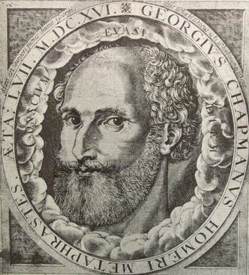Shakespeare's contemporaries
In the ferment of ideas, plots, images and stage effects, the dramatists of the early seventeenth century borrowed ideas from each other, competed, and admired each other. It is tempting, with our hindsight, to say that others borrowed from Shakespeare, but the truth is more likely that he borrowed as much as he gave.
This page and the following one offer brief comments on a number of the more important of those who were writing at the same time as Shakespeare. Many of them are worthy of study in far more depth than we accord them: Shakespeare's light naturally dims those of even the greatest of his peers.
Click on any of the names below to read more:
- George Chapman (1559-1634)*
- John Marston (1576-1634)*
- John Fletcher (1579-1625)*
- Francis Beaumont (c. 1584-1616)*
Footnotes
-
George Chapman (1559-1634)
Like his friend Ben Jonson, Chapman was an immensely learned man. His translation of Homer (1598-1616) was influential as late as the time of John Keats, and he wrote narrative and lyric verse as well as plays--both comedies and tragedies.
His most powerfully rhetorical tragedy is Bussy d'Ambois, based (like the tragedies of Webster) on recent sensational incidents on the Continent.
-
John Marston (1576-1634)
Marston, satirized by Jonson in the War of the Theatres for the obscurity of his style, was at his best a powerful satirist.
His plays are the product of his youth (later he entered the Church and became a clergyman, objecting strongly to the publication of his collected plays in 1633). At about the same time as Shakespeare wrote Hamlet, Marston wrote plays in the fashionable revenge genre (Antonio and Mellida and Antonio's Revenge); later he wrote two plays of dukes in disguise, like Measure for Measure, and again at about the same time (The Malcontent and The Fawn).
The best of his comedies is The Dutch Courtesan (1605). Like Dekker--though more satirically--he paints a realistic picture of contemporary London and its mores.
-
John Fletcher (1579-1625)
The names of Beaumont and Fletcher are linked in one of the most successful collaborations of the Renaissance--or any period. The two are said to have shared everything, even their women, and the attempts of critics to separate the two styles in their joint plays are as unconvincing as they are pointless.
The great plays of the partnership are discussed under Beaumont. Fletcher on his own wrote prolifically, mainly in the new, and fashionable, genre of tragicomedy (Shakespeare's last plays, Pericles, Cymbeline, The Winter's Tale and The Tempest are in the same genre), and he collaborated with others, including Shakespeare (Henry VIII and The Two Noble Kinsmen).
One curiosity of his output is a sequel he wrote to The Taming of the Shrew: The Woman's Prize, or The Tamer Tamed, in which, as the title implies, the woman (Petruchio's second wife) regains the upper hand.
Selected works by John Fletcher are available on line. Project Bartelby has some works by Fletcher.
-
Francis Beaumont (c. 1584-1616)
An aristocrat, Beaumont wrote plays for only a short period of his short life. One of the most original plays of the entire period is his Knight of the Burning Pestle, where a Citizen, his wife and apprentice, interrupt a comedy and insist on imposing their (obviously lower class) taste on the actors. Beaumont burlesqued earlier and current playwrights much as Shakespeare parodied earlier styles in the plays-within-the-plays of A Midsummer Night's Dream and Hamlet.
In his collaboration with Fletcher, the two wrote a series of romances, or tragicomedies in exotic settings: The Maid's Tragedy, Philaster, and King and No King. In tragicomedy they manage to have their cake and eat it: the action is tense, the rhetoric elevated, but the plot comes to a satisfyingly positive conclusion.
